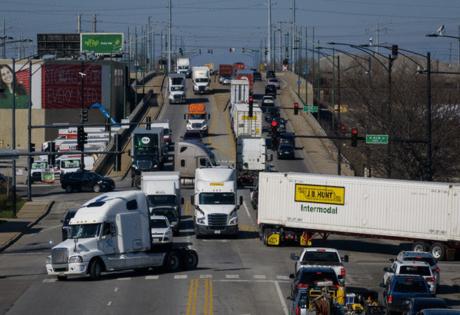Trump EPA moves to eliminate landmark scientific rule that's the basis for climate regulations
Published in News & Features
The Trump administration’s U.S. Environmental Protection Agency proposed on Tuesday revoking a science-based determination that pollution fueling climate change harms public health. The so-called endangerment finding has for 16 years underpinned federal regulations for vehicles, power plants and other sources under the Clean Air Act.
EPA Administrator Lee Zeldin announced the proposed rule change on a podcast ahead of an official announcement in Indiana, according to The Associated Press. The reversal was one of 31 environmental rules that Zeldin said in March the agency would roll back or repeal “to usher in the Golden Age of American success.”
But critics say the Tuesday decision flies in the face of scientific evidence, especially as climate change accelerates and manifests itself — through extreme heat, toxic algae blooms, intense tornadoes and other threats to the Great Lakes — and beyond in California wildfires, Florida hurricanes and Texas floods.
“Here in the Midwest, we’re seeing the consequences of a warming world,” said Howard Learner, executive director of Chicago-based Environmental Law and Policy Center. “The last thing we need is for the Trump administration to tie the EPA’s hands behind its back in this unlawful way that’s not grounded on prevailing legal standards, scientific reality or common sense.”
Up Next - Top Videos Cambodians cross Thai border to return home as clashes continue
The proposal follows an executive order from President Donald Trump that directed the agency to submit a report “on the legality and continuing applicability” of the endangerment finding.
The 2009 finding had established that carbon dioxide, methane, nitrous oxide, hydrofluorocarbons, perfluorocarbons and sulfur hexafluoride — heat-trapping gases released into the atmosphere by human activity — directly or indirectly threaten human welfare, specifically by driving climate change and extreme weather.
“It’s what it does in terms of the atmospheric impacts that contribute to public health harms,” Learner said.
According to the Centers for Disease Control and Prevention, health issues related to climate change include respiratory and cardiovascular disease, injuries and premature deaths from extreme weather events, changes in the prevalence and distribution of food- and water-borne illnesses and other infectious diseases, as well as threats to mental health.
For instance, heat is the leading cause of weather-related deaths. The flash floods in Texas earlier this month killed at least 138 people.
The EPA draft rule would be released jointly with a reversal of Biden-era limits on tailpipe emissions that were designed to encourage automakers to build and sell more electric vehicles, according to the AP. The transportation sector is the largest source of greenhouse gases in the country, accounting for almost a third of emissions.
The legal center will challenge what Learner called a “misguided” action from the Trump administration.
“We will engage before the EPA and its regulatory process and then go to court if, unfortunately, necessary,” he said. “Hopefully, the EPA will withdraw its proposal before it’s reversed by the courts on appeal, creating uncertainty in the meantime.”
If the decision is challenged in court, as it likely will be, the legal back-and-forth could leave industry in a state of limbo and harm the economy in the process.
This is not the first time the endangerment finding has been disputed, though this time, that challenge is coming from within. By 2022, the EPA had denied 14 petitions for reconsideration received between 2009 and 2019. And, after a series of lawsuits, the U.S. Court of Appeals for the District of Columbia Circuit upheld the determination in favor of the EPA in 2012.
The EPA’s new proposal comes less than a week after the International Court of Justice in The Hague, Netherlands, the United Nations’ top court, ruled that a clean environment is a human right. The landmark decision also said countries are legally obligated to curb emissions of greenhouse gases to curb climate change.
“So, when people say, ‘Well, that’s the International Court of Justice. What’s that got to do with Illinois?’ Illinois, in our own state constitution … Article 11 provides a right to a healthy environment,” Learner said.
The document reads: “Each person has the right to a healthful environment.” The article also says the state and its people have a duty “to provide and maintain a healthful environment for the benefit of this and future generations.”
“States like Illinois need to step up while the federal government is sadly stepping back,” Learner said.
In June, however, the Illinois General Assembly adjourned without passing the Clean and Reliable Grid Affordability Act, which would have expanded energy efficiency and encouraged renewable energy projects in the state.
Still, Illinois has other opportunities to tighten climate regulations at the state level. The General Assembly could pass the act in its fall veto session.
And earlier this year, the Illinois Pollution Control Board was considering switching to stricter California-style limits on truck emissions, which a Northwestern University study found would prevent 500 deaths per year in the greater Chicago region by 2050.
The Clean Trucks rule would require that manufacturers of medium- and heavy-duty trucks slowly sell an increasing percentage of zero-emission vehicles by 2035.
Proponents have argued that the rule would be “stronger than the otherwise-applicable federal vehicle emission standards,” according to a July 2024 board order accepting the proposal for hearing.
Possible hostility from the Trump administration, however, might dampen political will in Illinois and other states to move forward with proposed legislation similar to California’s clean-air truck and car rules, which the president has targeted and blocked.
While a state can tighten regulations for industrial sources under its own legal authority, federal rules help address issues that come from states sharing an environment that is not always bound by geography.
“As we all know, air pollution travels across borders,” Learner said. “One of the real challenges is that if Missouri and Iowa don’t regulate greenhouse gases, and Indiana doesn’t regulate greenhouse gases, then Illinois’ actions to reduce greenhouse gases here are surrounded by other states that are doing nothing.”
_______
©2025 Chicago Tribune. Visit chicagotribune.com. Distributed by Tribune Content Agency, LLC.







Comments